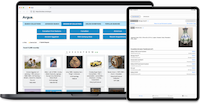Application Information that Makes a Museum CMS Project Attractive

Rachael Cristine Woody
Grant applications often require in-depth project information in order for funders to review and adjudicate your request.
When it comes to considering funding applications that involve the museum Collections Management System (CMS) there are specific pieces of information that should be included in order for the application to be successful. This post differs from our previous post as it moves beyond the obvious things funders look for and delves into the information funders don’t know they need unless it’s missing.
If you’re still searching for a CMS project idea, please refer to my previous post: How to Identify Museum CMS Projects for Funding. If you’d like insight into what funders look for, please see last week’s post: What Funders Look for in Museum CMS Projects.
Information to Include
Funders rarely specifically ask for the information areas outlined below, and yet each is crucial. Missing any one of these areas can sink a good application, so be sure address each one thoughtfully in every application you create. The crucial, non-obvious information pieces are:
- The “Give a Damn” Reason
- The Problem to be Solved
- A Clear Solution
- Eligibility and Suitability
- Scoring Criteria
- Why You
The “Give a Damn” Reason
Funders need a reason to fund you. It’s not enough for you to present a project and ask for money. You need a reason why your project should be chosen over others to receive funding. In other words: Why should they “give a damn”? This is where we need a compelling narrative, a reason for “why?”, and something that sets your application apart from all the others.
The Problem to be Solved
It’s not enough for your project to be a project. It needs to address or solve a challenge. This can be one of the hardest areas for collection stewards to conceptualize because we already know this is critical work. Instead, reconsider the framing that it’s “just” for digitization and record creation. That seems like every day work—and the funder cannot differentiate why it is important to do this work over other work. Instead, consider what problem the digitization and record creation could solve—better collections management and increased user access! Of course it does. But we need to spell it out.
A Clear Solution
Just as we need to articulate a problem, we also need to articulate a solution. To continue our example from the previous section: Yes. The project results in digital surrogates and object data. We need to make the case for how those two things solve the problem we laid out. Again, this may seem obvious. But it still needs to be spelled out in the application.
Scoring Criteria
Many funders will provide a scoring rubric to help guide applicants on the information they should provide. It’s important to identify and directly address each scoring element. Reviewers will read dozens and dozens of applications so it’s important to very clearly call out and address each element they’re scoring you on.
Why You
This is a niche area of grant awards. As you apply, your project can appear exactly the same as other applicants. Not only, do you need to offer a “give a damn” reason, you also need to make the case for why your application—yes, yours specifically and your museum’s collection—should be the one to receive funding. This is where you should speak to your credentials and the unique aspects of the collection you intend to work on.
Conclusion
Now that we’ve covered what funders look for as well as the information to provide for a successful application, it’s time to review what we should look for when evaluating funding. Not all funding is good funding or appropriate funding, especially with museum CMS projects. Please join us next week to close the series with a look how to determine the best funding match for your CMS project.
Additional Grant Funding Resources
- A Survivor’s Guide to Museum Grant Writing: https://lucidea.com/grant-writing-ebook/
- Webinar Suite: https://lucidea.com/project_category/rachael-woody-webinars/
- Lucidea Grants Directory: https://lucidea.com/grants-directory/
- Lucidea Grants Workbook & Templates: https://lucidea.com/grants-directory/grants-workbook-and-templates/
Additional Reading

Rachael Cristine Woody
Energized by this post? Please join us for the companion webinar How to Construct Museum CMS Projects that Attract Funding, August 28, 2024 at 11 a.m. Pacific, 2 p.m. Eastern. (Can’t make it? Register anyway and we will send you a link to the recording and slides afterwards). Register now.
**Disclaimer: Any in-line promotional text does not imply Lucidea product endorsement by the author of this post.
Never miss another post. Subscribe today!
Similar Posts
Exploring No-Code Digital Storytelling: Hoover’s “Fanning the Flames” Exhibit
Explore no-code digital storytelling with Hoover’s ‘Fanning the Flames’ exhibit. See how interactive tools (Deep Zoom Color Compare & Hot Spot) enhance user engagement and the visual experience.
An Introduction to Scrollytelling for Museums
Discover how museums use scrollytelling and digital storytelling platforms to create immersive narratives. This introduction explores key concepts and approaches to interactive storytelling.
Exploring Self-Determinate Multiple Pathways: An Example of Digital Storytelling
Discover how self-determinate multiple pathways offer flexible interactive storytelling in museum exhibits. Learn from the Tenement Museum’s ‘Your Story Our Story.’
Digital Museum Storytelling Example: A Look at Self-Determinate Linear Pathways
Self-determinate characteristics on a linear pathway go beyond brief sidebar topics and instead offer alternative ways to navigate the linear pathway.







Leave a Comment
Comments are reviewed and must adhere to our comments policy.
0 Comments